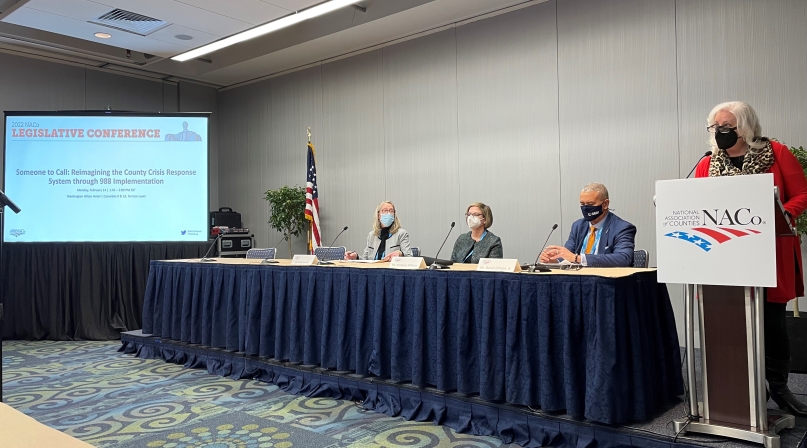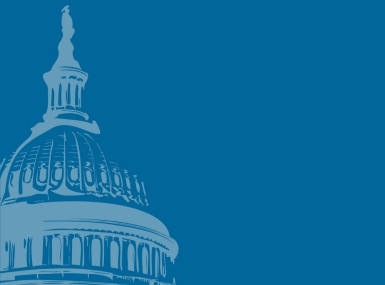Someone to Call During a Behavioral Health Emergency: Transitioning to 988 in Every County
Upcoming Events
Related News

Key Takeaways
Counties are integral to America’s behavioral health system and will be a vital force for building robust continuums of care for people with behavioral health conditions such as mental illness and/or substance use disorders. The over $100 billion in annual investments made by counties into community health systems directly supports behavioral health services such as those that enhance the crisis care continuum. Resources include but are not limited to crisis hotlines, mobile response teams, crisis triage centers and connections to local service providers that can help residents with behavioral health conditions receive timely and effective treatment.
An important component of this continuum of care are crisis hotlines to assist residents who experience a behavioral health emergency. Having someone to call during such an emergency is a critical entry point to access stabilization support, triage services and connections to treatment. Counties are preparing to add another resource to their toolkit – 988. During NACo’s 2022 Legislative Conference, counties learned more about this transition and how to prepare.
What is 988?
Every resident in every county currently has access to the Lifeline, and 988 provides a new pathway with an easy-to-remember number.
The nationwide transition to 988 on July 16, 2022 provides an easier way for people experiencing mental distress to access the existing National Suicide Prevention Lifeline. This three-digit number will connect callers to trained counselors 24 hours a day, seven days a week, via text, chat or phone. The Lifeline is available to callers at no cost and offers specific lines for veterans and Spanish-speakers. Counselors provide immediate guidance during a behavioral health emergency to decrease distress and suicidality.
How 988 Works
When someone calls 988, they will reach one of 180 existing Lifeline call centers across the country. Calls are directed to the closest call center based on the person’s area code, and a national center provides backup to ensure that no call goes unanswered. While many urgent concerns can be addressed with trained counselors over the phone, sometimes callers need another level of care or follow-up. Residents who call 988 from communities with behavioral health supports such as mobile crisis teams or crisis centers can receive immediate referrals to services from the 988 counselors.
Why 988 Works
The existing Lifeline saves lives and resources. In 2020, it received nearly 2.4 million calls, and jurisdictions expect a demand increase with the launch of 988. The Lifeline provides instant assistance by answering almost every call within 60-90 seconds. This quick response time is critical when someone is experiencing a behavioral health emergency. Over 90 percent of callers to the Lifeline reported that the initial call stopped them from committing suicide. Furthermore, with less than 2 percent requiring emergency services, this intervention decreases the use of jail and emergency rooms.
What Counties Can Do to Prepare for 988
In advance of the July transition to 988, counties can educate first responders and community members about the service, bolster or develop behavioral health services and coordinate across stakeholders. For example, Chester County, Pa. and Montgomery County, Ohio are using this important time to develop an infrastructure plan in anticipation of increased calls. Counties may consider ways to improve coordination and integration between agencies and providers to assist callers. Some counties, including Los Angeles County, Calif. and Pima County, Ariz., have physically or virtually co-located 911 operators and behavioral health clinicians to coordinate protocols and messaging.
In geographically dispersed areas, counties may provide law enforcement officers dispatched from 988 calls with technology such as iPads to increase community members’ access to telehealth and telepsychiatry. Harris County, Texas, Pennington County, S.D. and Avery County, N.C. have implemented this practice. Grand Lake Mental Health Center in Northeast Oklahoma serves 12 rural counties and equips police officers with iPads that connect to the Center’s crisis workers who can virtually de-escalate a situation.
Counties may also benefit from learning how state partners plan to implement 988 and finding state-supported opportunities to build the capacity of the behavioral health continuum of care. County leaders may consider using American Rescue Plan Act resources to fund local 988 implementation and a behavioral health continuum of care. Counties continue to play a critical role in supporting community members with behavioral health conditions and have an opportunity to enhance those services during 988 implementation.
Additional Resources
The following resources provide additional information on the 988 transition and a behavioral health continuum of care.
- FCC approves texting ‘988’ to expand access to the Suicide Prevention Hotline by next year
- NACo Policy Brief: Fund Local Crisis Response Efforts
- Vibrant Emotional Health and 988
- Vibrant Emotional Health’s 988 and the National Suicide Prevention Lifeline
- NACo Webinar: Before and After a Behavioral Health Crisis: Building a Continuum of Care
- NACo Webinar: Investing ARPA Funds in Behavioral Health Crisis Response
- SAMHSA’s 988: America’s Suicide Prevention and Mental Health Crisis Lifeline FAQ
- The Lifeline and 988



